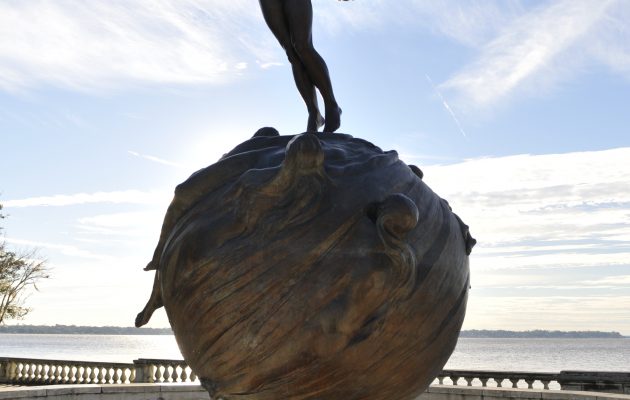Art through the years sparks debate, tests values
Posted on December 30, 2014 By Editor Articles, Neighborhood News, Top Stories

Celebrating a monument, while appreciating opinions
On Christmas Day in 1924, a sculpture that paid tribute to fallen Floridians from the First World War was unveiled after a long road to completion.
Ironically, 90 years later, as the anniversary of Riverside Memorial Park reaches a milestone, we find ourselves in a debate over public art. The statue Life, often referred to as Winged Victory, by sculptor Adrian Pillars, drew sharp criticism concerning the nature of a nude male in the park. While some things change over time, some remain the same in public discourse.
Shortly before Thanksgiving, City Council President Clay Yarborough wrote to Mayor Alvin Brown protesting a photograph of a nude pregnant woman in a display at the Museum of Contemporary Art [MOCA]. His request to have the city’s $230,000 grant to MOCA revoked created an enormous backlash of public and private protests.
Leaders in the cultural community spoke out in support of MOCA, noting that nudity in the art form has been on display for centuries.
In a letter from Hope McMath posted on The Cummer Museum of Art & Gardens blogsite, the museum director stated, “History is filled with art works expressing the human condition through the nude form. More specifically, there are masterworks across millennia and geographic boundaries that illustrate the state of motherhood; being found in works ranging from the Venus of Willendorf’s swollen belly and pendulous breasts to Mary nursing the Christ child in thousands of Renaissance paintings and sculptures. Museums, houses of worship, and street corners across the globe are filled with such images. There is hardly a gallery at the Cummer Museum that is not populated by the nude body.”
MOCA director and chief curator Marcelle Polednik echoed McMath’s sentiments, stating “The nude has been a staple of artistic expression and practice for millennia. The first ostensible artistic form, the ‘Venus of Willendorf,’ was a nude woman, a fertility symbol. In the early twentieth century, as exemplified by the statue of ‘Life’ in Memorial Park, the nude frequently appeared, as it has for centuries, as a symbol of humanity, of hope, and as a reminder of the frailty of our corporeal beings and the transcendence of the human spirit.”
History repeating
Nine decades earlier, when Memorial Park was dedicated on Dec. 25, 1924, a monument was unveiled by two young girls to commemorate the 1,200 soldiers from Jacksonville who served and died in World War I.
According to a book published in 1976 by George Hallam, Riverside Remembered, he wrote about the stir caused by the statute: “No sooner had six men and a crane set the ball and fountain with its winged bronze statue in place…than some good ladies protested the appearance in the park of a nude male.”
Life has been the subject of countless photos ever since that unveiling, a scenic “magnet” to both amateur and professional photographers.
Memorial Park Association is in the process of raising funds to renovate the park and restore it to its former landscape glory, of which nearly $400,000 will be used to have the statue cleaned and the fountain repaired.
The statue has received more than one “facelift” over the years. In 2004, the 22-foot bronze statue was cleaned to remove corrosion, polished to lighten it and coated with a protective material to retard further corrosion. That project cost $40,000 and was done by Objects Conservation, a St. Louis-based company, which had also restored the statue in 1992 while making repairs to the reflecting pool.
Life, in all its naked glory, stands as a monument to those who sacrificed their lives in a war against a German regime that would later target artists and other creative groups in an attempt to cleanse society of such ilk. For children and grandchildren of the “Greatest Generation,” who fought in World War II against ethnic cleansing and other atrocities, standing up for artistic expression – with or without the benefit of clothing – is nothing more than upholding a freedom from persecution.
As it went with Life, so it goes with Angela Strassheim’s photographic artwork on display at MOCA. Some will find reasons to object; others will embrace the artistic expression and the intention behind the work.
By Kate A. Hallock
Resident Community News




 (1 votes, average: 5.00 out of 5)
(1 votes, average: 5.00 out of 5)




